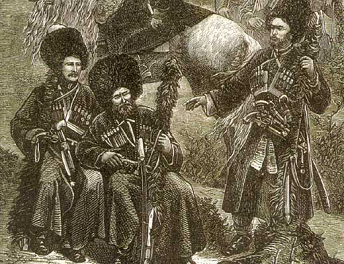We come from the past By Usam Baysayev, special to Prague Watchdog
Samashki, Chechen Republic
"History," said Alexandre Dumas père, "is the nail on which I hang my novels." While such an approach may be forgivable in a novelist, it is more problematic when adopted by those “researchers” who study today’s reality, or who seek to predict the future through the study of the past. The extraction from the historical process of convenient "nails", or facts, may make it possible to manufacture ideas that are convenient from the point of view of political expediency but false as regards their content. Examples of this are the alleged voluntary nature of the Chechens’ accession to the Russian state, or our supposedly unconditional support for the Bolsheviks during the Civil War of 1917-1923.
Something similar happens when attempts are made to reduce the Chechen national liberation movement to the status of an isolated ethno-political project which has only a very limited connection with Islam and the rest of the Caucasus. My own view is that anyone who argues this is not very well acquainted with the history of Chechnya.
Let us take, for example, the case of Beybulat Taymi, who is sometimes referred to as a nineteenth century secular Chechen leader. While on the one hand he tried to stir the Daghestanis to ghazavat (jihad), on the other he endeavoured to unite his hesitant compatriots, who had not yet realized how destructive Yermolov’s policies were. In other words, as elsewhere in Chechen history the national liberation movement contained elements both of religious fervour (Islamism, if you like) and of features that were common to the Caucasus as a whole.
Unlike modern scholars, the Tsar’s generals were well aware of this peculiarity of ours – the striving for freedom combined with the organization of life in accordance with Islamic rules. It is no accident that Prince Alexander Baryatinsky’s appeal of 1859 offered the Chechens internal autonomy in exchange for ending the war, together with a judicial system based on Sharia law. When in response it received a series of powerful uprisings, the tsarist government subsequently went back on its promises.
First Tapa Tchermoeff and other Chechen leaders headed the attempts to create an independent pan-Caucasian state. It initially included non-Muslims, in particular the Ossetians, and even the Cossacks. Soon after came the North Caucasus offensive of Denikin’s volunteer army. The independent Mountain Republic fell, in no small measure because the Christians who belonged to it supported the White Guards. The Republic was replaced by a North Caucasus Emirate – a theocratic Islamic state, which claimed to be the successor of Shamil’s Imamate, and which naturally came with all the bells and whistles: Sharia law and a striving to unite all the Muslim mountain peoples under its flag.
Having been forced into an alliance with the Islamists (let us call them that) in the face of a common enemy, the Bolsheviks were later afraid to engage them in open confrontation. The Islamists were dealt with by populist slogans, poison and bullets – and one way or another, the Emirate’s leaders left the political stage.
Realizing that the highlanders’ Islamic and pan-Caucasian aspirations were inseparable from their desire for personal and national freedom, the central Soviet government offered them very nearly the same project: a Mountain Republic under Sharia law, with a very high degree of internal autonomy. For a while units of the Red Army were even not deployed on its territory. Not long after, however, the Mountain Republic collapsed. First its backbone – Chechnya – was removed, and then repression of the kulaks, the mullahs, and the intelligentsia began. This was met by uprisings and quite understandable demands for the reinstatement of Sharia law and a return to the promises that had been given to the highlanders at the time of the formation of their shared autonomy in 1920.
It is not really possible to bring the history of the Chechen liberation movement under a common denominator, to define it as an ethno-political project and then say that it was replaced by an Islamist or pan-Caucasian one. All of these elements are present in the story, acquiring a greater or less degree of importance at different periods, under the influence of changing external circumstances and existing in interaction with one another.
.
If we look at more recent history, at the declaration of Chechen independence in 1991 and what happened immediately after, we see that the republic’s leadership tried to encourage other North Caucasus ethnic groups to take the same route, and took an active part in the Confederation of Peoples of the Caucasus. Shamil Basayev sided with the Abkhaz separatists, in the hope that Abkhazia would become be a western outpost of Ichkeria. But the Chechen leadership stayed out of Prigorodny region and the defence of the brother Ingush, realizing among other things that this might upset its role as arbiter in the Caucasus, as the centre around which the nations could unite. Chechnya thought of itself as a locomotive which was capable of hauling away from Russia if not the entire Caucasus, then at least a part of it.
The Chechens are Muslims, and the legal system they have chosen is Sharia law. It would be strange if this were not so. Even in Soviet times the republic was founded on a system of justice derived from Sharia. It can therefore be argued that Chechen separatism is at once an Islamic, an ethnic and an international project. We should recall that even the predictions of the Sufi saints, who are beyond suspicion in the republic, mention the forthcoming liberation of the entire Caucasus. The northern boundary of the future Muslim state is given. It is Idal khi – in English, the River Don. Not even the supporters of Dokka Umarov’s Caucasus Emirate argue with that.
Picture: vokrugsveta.ru. (Translation by DM) (P,DM)
DISCUSSION FORUM
|

